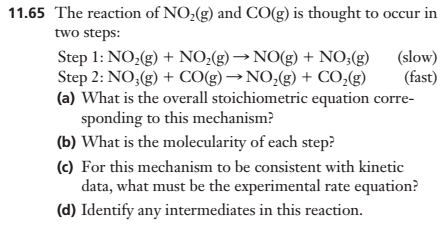
Interpretation: Reaction of
Concept introduction:
Stoichiometric ratio represent the molar ratio of all the products and reactants and products, but not the intermediates participated in the reaction mechanism.
Molecularity is a theoretical concept and should not be negative, zero, fractional, infinite and imaginary. Molecularity is the total number of reactant molecules or atoms taking part in the
Answer to Problem 11.71PAE
Solution:
(a) Stoichiometric equation
(b) Molecularity
Step 1- 2
Step 2 − 2
(c) Experimental rate equation
(d) Intermediates
Explanation of Solution
(a) The molar ratio of the reactant molecules, products in balance equation is called stoichiometry. Some reactions take so many steps to achieve their final products. There can be so many intermediates. But those are not involved in the balanced equation. If a reaction takes so many steps to give their final products, by adding them together we can their stoichiometric equation.
Then we should cancel out same molecules present in both side, we can write overall reaction as follows,
(b) Molecularity is the total number of reactant molecules or atoms taking part in the chemical reaction.
Therefore, molecularity of step1 is 2 and molecularity of step 2 is also 2
(c) Rate equation can be written using either product or reactants. If take reactants, we should concern the reduction rate of reactants. If we take product, we should concern the growth rate of products.
Some reactions should follow many steps to give their final product. In between these steps they will form intermediates. Intermediates don’t involve in the overall reaction. And they cannot be separated out. Here,
(d) are intermediates since they were produced by interaction of reactants, but they involved in further reactions to result in different final products.
In a reaction mechanism, more than 1 step is involved although only one could be rate determining. Intermediates are formed within the process and are not present in the final stoichiometric equation.


Want to see more full solutions like this?
Chapter 11 Solutions
Chemistry for Engineering Students
- Show the mechanism steps to obtain the lowerenergy intermediate: *see imagearrow_forwardSoap is made by the previous reaction *see image. The main difference between one soap and another soap isthe length (number of carbons) of the carboxylic acid. However, if a soap irritates your skin, they mostlikely used too much lye.Detergents have the same chemical structure as soaps except for the functional group. Detergentshave sulfate (R-SO4H) and phosphate (R-PO4H2) functional groups. Draw the above carboxylic acidcarbon chain but as the two variants of detergents. *see imagearrow_forwardWhat are the reactions or reagents used? *see imagearrow_forward
- The two pKa values of oxalic acid are 1.25 and 3.81. Why are they not the same value? Show the protontransfer as part of your explanation. *see imagearrow_forwardасть Identify all the bonds that gauche interact with C-OMe in the most stable conformation of the above compound.arrow_forwardPredict the reactants used in the formation of the following compounds using Acid-Catalyzed dehydration reactionarrow_forward
- Can I please get help with this?arrow_forward.. Give the major organic product(s) for each of the following reactions or sequences of reactions. Show ll relevant stereochemistry [3 ONLY]. A H Br 1. NaCN 2 NaOH, H₂O, heat 3. H3O+ B. CH₂COOH 19000 1. LiAlH4 THF, heat 2 H₂O* C. CH Br 1. NaCN, acetone 2 H3O+, heat D. Br 1. Mg. ether 3. H₂O+ 2 CO₂ E. CN 1. (CH) CHMgBr, ether 2 H₂O+arrow_forwardAssign this COSY spectrumarrow_forward
 Physical ChemistryChemistryISBN:9781133958437Author:Ball, David W. (david Warren), BAER, TomasPublisher:Wadsworth Cengage Learning,
Physical ChemistryChemistryISBN:9781133958437Author:Ball, David W. (david Warren), BAER, TomasPublisher:Wadsworth Cengage Learning, Chemistry for Engineering StudentsChemistryISBN:9781337398909Author:Lawrence S. Brown, Tom HolmePublisher:Cengage Learning
Chemistry for Engineering StudentsChemistryISBN:9781337398909Author:Lawrence S. Brown, Tom HolmePublisher:Cengage Learning Chemistry: Principles and PracticeChemistryISBN:9780534420123Author:Daniel L. Reger, Scott R. Goode, David W. Ball, Edward MercerPublisher:Cengage Learning
Chemistry: Principles and PracticeChemistryISBN:9780534420123Author:Daniel L. Reger, Scott R. Goode, David W. Ball, Edward MercerPublisher:Cengage Learning Introduction to General, Organic and BiochemistryChemistryISBN:9781285869759Author:Frederick A. Bettelheim, William H. Brown, Mary K. Campbell, Shawn O. Farrell, Omar TorresPublisher:Cengage Learning
Introduction to General, Organic and BiochemistryChemistryISBN:9781285869759Author:Frederick A. Bettelheim, William H. Brown, Mary K. Campbell, Shawn O. Farrell, Omar TorresPublisher:Cengage Learning Chemistry by OpenStax (2015-05-04)ChemistryISBN:9781938168390Author:Klaus Theopold, Richard H Langley, Paul Flowers, William R. Robinson, Mark BlaserPublisher:OpenStax
Chemistry by OpenStax (2015-05-04)ChemistryISBN:9781938168390Author:Klaus Theopold, Richard H Langley, Paul Flowers, William R. Robinson, Mark BlaserPublisher:OpenStax Chemistry & Chemical ReactivityChemistryISBN:9781337399074Author:John C. Kotz, Paul M. Treichel, John Townsend, David TreichelPublisher:Cengage Learning
Chemistry & Chemical ReactivityChemistryISBN:9781337399074Author:John C. Kotz, Paul M. Treichel, John Townsend, David TreichelPublisher:Cengage Learning





